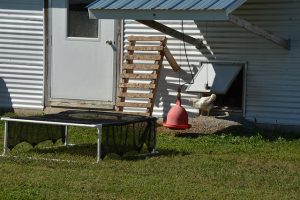This past Saturday, September 9th, I had the opportunity to go to a Poultry Farm. Georgie Cartanza has been in this business for quite some time now. She’s been growing organic chickens for the past 11 years and previously worked for Perdue. When it comes to growing organic chickens, they’re certain requirements and guidelines one must follow. This poultry farm consisted of four houses that were 65×600 feet long, each house had roughly 37,000 chickens in each house for a total of roughly 148,000 chickens. Each house had ventilation, air-conditioning, automatic water and food machines that filled up by itself, and lastly an outdoors area for the chickens to go out if pleased. Georgie produces enough chicken to feed nearly 60,000 families for roughly 5 million pounds of chicken a year. Going into this trip, I had knowledge about chickens but no knowledge of how poultry farms functioned rather just my own opinions. I figured the housing and conditions were nearly as bad as people thought, and once visiting these houses, I realized I was correct that the environment was nice. The housing was much cooler than I expected and as well answered many of my questions. One question being how they harvested these chickens? I thought possibly there was some kind of machinery that made it easy but Georgie informed us that all the chicken are caught by hand. My second question was how much room would the chicken have to move and such? And once entering the house you realize the size of the house is more spacious than you would think. Overall, the field trip was quite interesting, I never thought I’d ever visit a poultry farm but I’m glad I did for I learned greatly.











